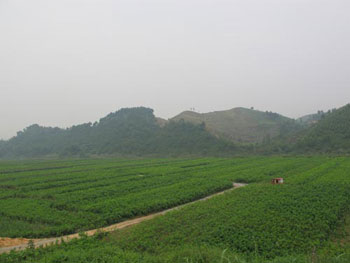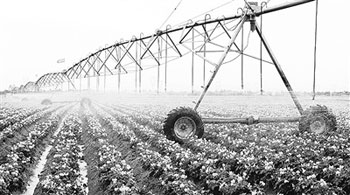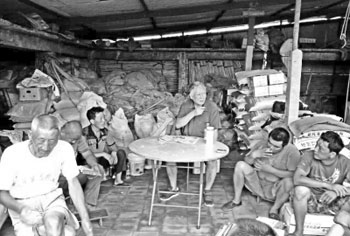Across the Darwin Dead Sea, soil remediation is outstanding in Guangxi.
Original title: the people of the Chinese Academy of Sciences overcame the difficulties and finally let the contaminated land grow crops.
Across the Darwin Dead Sea for soil remediation

After the management, a lush mulberry garden has been formed (network picture)
In Huanjiang County, Guangxi, the contaminated land used to be barren and abandoned for nearly a decade. After years of restoration by the Environmental Restoration Center of the Institute of Geographic Resources of the Chinese Academy of Sciences, the land has finally grown crops and produced qualified agricultural products.
In the treatment site of heavy metal pollution area in Guixi, Jiangxi Province, the once barren land is now lush. What makes Zhou Jing, a researcher at the Nanjing Institute of soil Research of the Chinese Academy of Sciences, more gratified is that the surrounding landscape and water quality have changed, and the content of cadmium and copper in the stream has dropped by 70% to 80%.
In a certain place in Hunan, the Huang Daoyou team of the Institute of subtropical Agricultural Ecology of the Chinese Academy of Sciences is using a number of treatment models and technologies such as constructed wetlands to purify irrigation water sources, so that the mining field 5 kilometers upstream is no longer a threat to the safety of rice in farmland.
"organizing forces from relevant fields of the Chinese Academy of Sciences together to fight as a team is easy to learn from and improve each other, and it is more effective than working alone." Recently, Chen Tongbin, director of the Environmental Restoration Center of the Institute of Geographic Resources of the Chinese Academy of Sciences, told China Science Daily at a meeting on the progress of the Chinese Academy of Sciences STS project "risk zoning and treatment techniques for heavy metal pollution in southern soil" held in Changsha.
The pain of transformation
Today, without having to visit the site in person, through the soil remediation supervision platform in the office in Beijing, Lei Mei, deputy director of the Environmental Restoration Center of the Institute of Geographical Resources of the Chinese Academy of Sciences, can real-time and online observe the growth of Pteris vittata in soil pollution remediation sites in Shimen, Hunan and Huanjiang, Guangxi, and obtain parameters such as temperature and humidity, wind speed, rainfall, and so on.
Such results are hard to come by.
At the just-concluded two sessions, a new word emerged-"Darwin's Dead Sea". Xu Xudong, deputy director of the Institute of Aquatic Biology of the Chinese Academy of Sciences, used it to describe the difficult areas in the process of technological transformation.
Lei Mei has personal experience of this: generally in areas polluted by heavy metals in the soil, the necessary facilities, industrial chain, and other supporting technologies for transformation are not yet available, and the work is particularly difficult to carry out, because it is not only necessary to carry out research on pollution control technology. it is also necessary to promote the previous and subsequent supporting technologies in order to form an industrial chain.
"if we don't do this kind of transformation, who wants to do it?" Lei Mei asked herself.
Many polluted areas are not economically developed areas, and there are many difficulties in transforming technological achievements. This leads to greater technical risks, many enterprises do not want to get involved in the field of farmland pollution control, and it is impossible for local governments to spend too much money to support them.
"such being the case, we must take into account the agricultural characteristics of the polluted areas and the acceptance of farmers, and tailor the form of transformation of achievements in line with local development." Lei Mei said.
Dealing with the "death trap" of technology
"the last kilometer from technology to application is often the most difficult. The connection between different fields and different stages is the weakest. " Chen Tongbin sighed.
The difficulties are also magnified with the application of technological achievements. Chen Tongbin said that although the original innovation component of technology has declined relatively, there are more and more interference and constraints, more and more complex problems, and more and more time and capital investment. At the same time, the control ability and importance of scientific and technological personnel have also declined relatively, and the risk of failure has increased rapidly.
In his view, technological "death trap" and "Darwin Dead Sea" are universal laws. The difficulty in the transformation of scientific and technological achievements is basically a common problem facing the world, but the disconnection between science, technology, product (engineering) and industry in China is more serious.
The STS project, the Science and Technology Service Network Plan of the Chinese Academy of Sciences, is being created to deal with the problem of technology transformation. It is one of the important measures to deepen the reform of the scientific and technological system of the Chinese Academy of Sciences, which aims to further enhance the ability of the Chinese Academy of Sciences to transfer and transform scientific and technological achievements and serve the national and local economic and social development.
One of the characteristics of the STS plan is to mobilize and organize the scientific and technological forces of the Chinese Academy of Sciences, integrate and integrate the elements of innovation, adjust and optimize the business model, and carry out systematic, networked and integrated work under the guidance of national, social and market demand.
"now, once the research results of many laboratories are introduced into practical engineering, they are completely different. The STS project is to deal with this problem, facing the needs of users. " Said one executive who spoke on condition of anonymity.
In the view of Luo Yongming, director of the Yantai Coastal Zone Institute of the Chinese Academy of Sciences, this work can summarize many integrated innovations extracted from practice, rather than just simple technical convergence. "this is the characteristic of the work of the Chinese Academy of Sciences."
Provide support for decision-making, market and society
The Chinese Academy of Sciences has a long-term accumulation in the treatment of soil heavy metal pollution, and has created a dominant team to develop a variety of soil pollution remediation and resource utilization technologies, such as phytoremediation, physicochemical remediation and other technologies. Industry experts believe that the work of the Chinese Academy of Sciences is leading in the treatment of heavy metal pollution in farmland soils.
The current situation is to explore more economical and simpler technologies while demonstrating. "the Chinese Academy of Sciences is only technical support and should not replace the engineering implementation role played by enterprises in soil remediation projects. If we all go and finish the project, we won't be scientists. " Experts say that at the same time, the technology should not only be simple, but also advanced and easy to use.
It is understood that the Chinese Academy of Sciences will further promote the construction of a national comprehensive demonstration zone for the treatment and remediation of soil heavy metal pollution, carry out "regional classification" treatment according to different typical pollution areas, different pollution types and pollution degrees, and initially establish a national network demonstration platform with the support of relevant state departments. (our reporter Wang Hui)
- Prev

Sino-Israeli cooperative scientific and technological innovation private equity venture capital panning for gold in the land
Sino-Israeli cooperative scientific and technological innovation private equity venture capital panning for gold in the land
- Next

The elderly with agricultural materials are looking forward to the high yield of organic matter in spring.
The elderly with agricultural materials are looking forward to the high yield of organic matter in spring.
Related
- A course of planting techniques and methods on how to grow carrots
- How to plant the latest tulips?
- Is it better to pick tea in the morning or in the afternoon? When is the best time for tea to be picked? what is the third or fifth tea?
- Launch Yuanxiao Happy combination Haocha + Tea Yuan healthy Taste
- Penghu Tourism "Fireworks 20 Parade with You"
- 2022 West Lake Happiness holds "Digital Revitalization Voucher" and draws iphone13 and laptop.
- Banqiao Fuzhou social houses are designed to change start-up combined with police elimination to create a safe and livable environment
- The convenient measure of "mechanical weeding" in Xinbei has been abused and the Agriculture Bureau has imposed heavy penalties on the illegal land consolidation.
- Changgeng University Joins Hands with Four Memory Factories to Rescue Memory Talent Shortage
- The list of Taiwan's top 100 MVP managers is listed by the Director-General of the Farmers' Association of Sanxia District.

